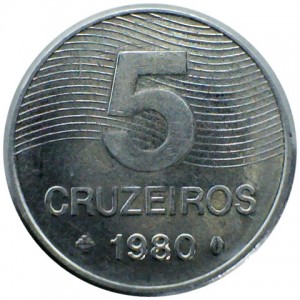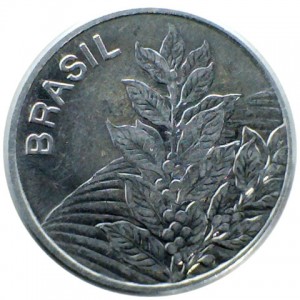When I started this blog, I resolved to use my Google Analytics results to decide which country I would choose when selecting the next coin for display. I was quite surprised to find that Brazil has been the second highest source of visitors to my site in the last month. I have very few Brazilian coins and, because they are uncommon in Africa, the ones I have are rather banged up. Additionally, I know very little about the currency of Brazil but, thankfully, I do rather like coffee!
Brazil is an example of a country that experienced, and then recovered from, a rampant inflation crisis. Having used the historic Real as currency from the 1790s until 1942, the nation moved onto the Cruzeiro, subdivided into 100 Centavos, at a rate of 1000 Réis to one Cruzeiro. This currency was named after the Southern Cross constellation. The first Cruzeiro (now called the “Cruzeiro antigo”) was replaced in 1967 with the Cruzeiro novo at a rate of 1000 “antigos” to one “novo”. In 1986, this second Cruzeiro was replaced with the Cruzado, again at a rate of 1000 to one. This was replaced in 1989 with the Cruzado novo at 1000 to one. In 1990, the Cruzado novo was renamed and became the third Cruzeiro. In 1993 the third Cruzeiro was replaced with the Cruzeiro Real, again at a rate of 1000 to one. However, the Cruzeiro Real was not a circulating currency. In circulation, it was replaced with the Real at a rate of 2750 Cruzeiro Reals to one.
That is tough to follow but it means that if you saved up 2 750 000 000 000 000 000 of the 1942 Reals and upgraded them with each currency change, you would have 1 Real today. Of course, this doesn’t reflect the actual value of goods but it is nevertheless chilling to think of how fragile currencies can be over the course of a single human lifetime. Nevertheless, Brazil recovered and has enjoyed a comparatively stable currency in the form of the Real since 1993.

The fetching reverse design of a 1980 Brazilian 5 Cruzeiro, featuring the value on a ribbon and a coffee been alongside the date.
The coin on display is a 5 Cruzeiro piece falling into the 1967 to 1986 Cruzeiro novo period. The coin is struck in stainless steel, like many Brazilian coins. This makes it very durable and attractive, but devilishly difficult to photograph. My example is far from being in perfect condition but it is one of the few South American coins in my collection. The obverse depicts a coffee plant against the background of a coffee plantation, and the reverse echoes this with a coffee bean to the right of the date.
